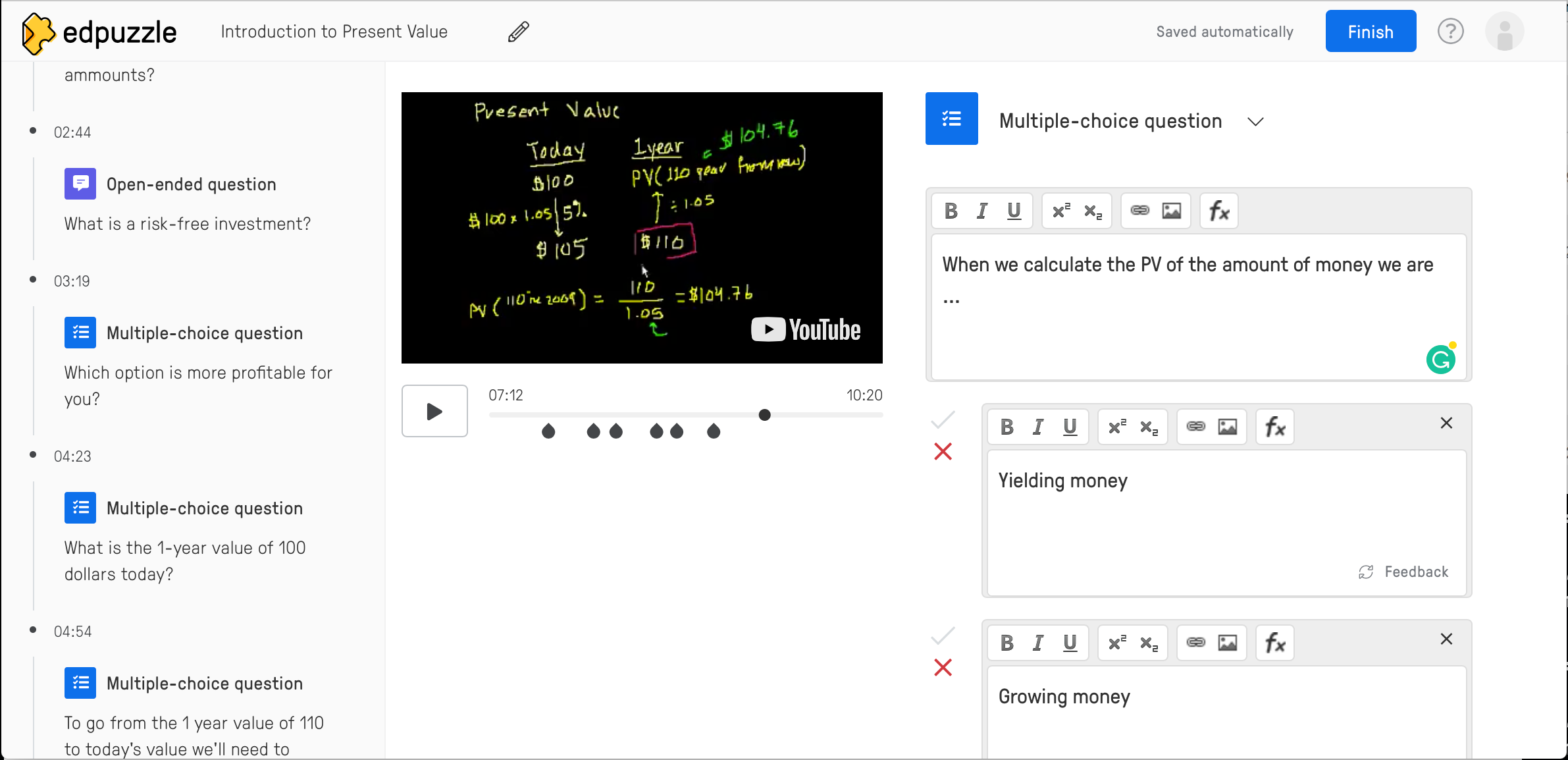Keep your students engaged and learning
We all know remote teaching is challenging. While we know online classes are the best option in the current context, there is no secret about how difficult it can be to ensure students’ learning and active involvement.
Let’s be honest, Zoom classes and traditional slides are not enough. Students are not participating, and unfortunately, they are not learning. This is not completely their fault. It’s not because they don’t care, but because they struggle. They struggle to stay focus; they struggle to connect with others; they struggle to become active learners.
And it’s not our fault either, we are all doing our best. We are trying to adapt to extreme circumstances, without proper training, support, or even enough time to change the curriculum.
The good news is that there are plenty of tools and online resources out there to help us make our classes more engaging and interactive.
To save you time and help you choose the right tools for your classes, I have selected 5 of my favorite tools for online education. In this post, I’ll give you a hint to some of the best-in-market, low-budget, and user-friendly applications for improving the online learning experience and some ideas on how to use them.
Let’s start.
1. Explain Everything
Explain Everything is my favorite interactive whiteboard platform. And quite frankly is much more than a collaborative whiteboard. With Explain Everything, you can create video beats about your lecture topics and share it with students to check for understanding. You can either record your slideshow while you speak, or draw and write on the whiteboard and record everything you said and add to it.
Another pretty interesting functionality is the collaborative whiteboard. You can create groups and invite your students to collaborate on projects. Students can work on cloud projects simultaneously or at their own pace, and you have an eye on their work in real-time. This is great both for synchronous and asynchronous group work. What I love about this is that participants that join the whiteboard at the same time can hear one another thanks to their audio chat.
Finally, you can also livecast your whiteboard and keep your online classes engaging. Either by using a videoconferencing system (Zoom, Microsoft Teams, Google Meet, etc) or just by sharing the whiteboard link, participants can see in real-time what’s happening. This is a great option for big sized synchronous classes.
Explain Everything is free up to three simultaneous projects, but for only 3 dollars per month, you get access to unlimited projects, slides, and recordings.
2. Mural
Mural is also one of my favorite apps for interactive online learning and visual collaboration. Mural is essentially a remote design thinking platform, but its potential for education is outstanding.
As an educator, you can invite up to 100 members or guests to your workspace and collaborate with students and other faculty in real-time. You can have dedicated rooms for each class or group of students to encourage teamwork and project-based learning. Inside each room you can create several murals that can be set to private or public, depending on how you want to share it.

Mural works as a big whiteboard that you can organize in different small areas to outline your lecture session. From course kick-offs, warm-ups and energizers, brainstorming, traditional slide-decks, the possibilities with Mural are infinite.
The functionalities I love the most are their chronometer, the celebrate button, and the facilitator superpowers. With the chronometer you can set up timing for each activity in the Mural and thus plan with more precision each of your lectures, ensuring also time for breaks. The celebrate button is just a lovely confetti party that you can throw every time the class completes an activity. Everyone will get the confetti party on their screen. This is great for rewarding effort and progress. Finally, you can assign Facilitator superpowers to your students so they take the leader role on their team. Facilitator superpowers include the possibility of timing activities, start voting sessions, and celebrate task completion. Giving facilitator superpowers to students is an original way to engage your students and make them accountable for their learning.
Mural is free for educators and students. You just need to create an account with your institutional address and provide proof of your status. For an education plan you can apply here.
3. Playfactile
PlayFactile is a learning platform that lets teachers create engaging Jeopardy-style quiz games for the classroom. You can create and personalize your own game boards or use pre-made quizzes shared by the community. With PlayFactile you can either host live jeopardy games, regular multiple choice quizzes, memory games, and create study flashcards to improve students’ learning proficiency.

These jeopardy games can be a great option to complement the traditional slide lectures, as you can divide the board into different topics and use it as a kick-off or wrap up activity. Students can then review their learning while playing, and you can instantly complement concepts when doubts arise.
Students can play individually or in teams and they can choose beautiful avatars and nicknames. You can control whether they use their names or a default nickname.
With the free version, you can create up to 5 teams for each game and you can host up to 3 games. With the education version, only 5 USD per month, you can play and create as many games as you want and have over 50 teams. The premium account offers other amazing features like buzzer mode, memory and choice games, and share flashcards.
4. Edpuzzle
I recently came upon Edpuzzle and I’m convinced of its potential for enhancing online learning. Edpuzzle is a video platform where you can create and edit videos from the web and use them in your classroom. Take any video from YouTube, Khan Academy, Learn Zillion, or your own and build your lessons around them.
Video and visuals are more effective for learning than traditional slides, but most of us, teachers and professors, don’t have time to create sketch videos for every lesson. Here’s where Edpuzzle stands out. You can just turn existing videos from any platform and tailored them for learning.
You can use any video and transform it into engaging video lectures thanks to the embedded questions and voice-over features. You can just insert open-ended and multiple-choice questions all along the video to check for understanding. No need to reinvent the wheel.

Edpuzzle takes videos to another level, converting them into video lessons. If you want to make sure your students watch and actually learn from the video, then Edpuzzle is just the right tool.
What I love about this app is that you can integrate it with Explain Everything to upload your whiteboard videos and convert them into quizzes. Edpuzzle is free.
5. Sli.do
Sli.do is a great tool for promoting active learning in online classes. It helps you involve your students in the lectures. The possibilities are endless. With Sli.do you can empower your students to ask questions, vote in polls, and be a part of the lecture by using a simple Q&A and polling tool.
- With polls, you can learn if your lecture’s content resonates with your students. You can also use them to drive meaningful discussions in your class.
- Use quizzes to find out how much your students remember from your lectures. Use them to recap the content from the last topic. Or motivate your students to pay attention during your lecture by hosting a live quiz.
- Use the Q&A feature to collect students’ questions and feedback throughout your lecture and address them as they come or in a dedicated Q&A session at the end of your class. You and your students can upvote and provide answers in real-time, making peer-learning possible.
Another awesome feature is the switcher app. With Slido Switcher, you can display polls or questions on top of your presentation using your smartphone as a remote control. Whether you use PowerPoint or Keynote, with the Switcher app you can change seamlessly between your presentation and the Slido event.
Sli.do offers an education package starting at $5 per month. But you can also use the free version for up to 100 participants and one event at a time.
If you, like me, are interested in making your online classes more engaging, then I’d love to hear what are your strategies and tools you are using in your classroom. Drop your comments with ideas or questions here below.
Ready to shift to Online Education? Subscribe to my newsletter and receive monthly tips and tricks on how to make your online classes more engaging.




